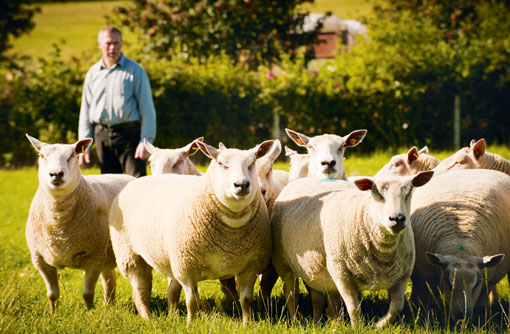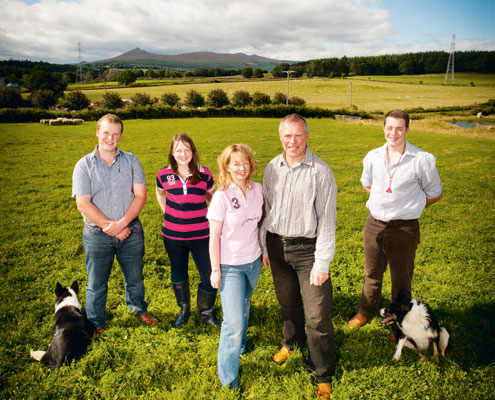Low-input grass-based system pays dividends for award winner

A focus on good grassland husbandry is the crux of a successful sheep farming enterprise, and for 2010 Farmers Weekly Sheep Farmer of the Year winners William and Carole Ingram, the focus on a low-input grass-based system pays dividends.
Together with sons Gregor and Bruce and daughter Amy, the family keep more than 2,000 ewes, split separately into four different flocks, at Logie Durno Farm, near Inverurie, Aberdeenshire. Some animals are sold as breeding stock to producers up and down the country, and the rest are sold to Woodheads for Morrisons.
William says: “Grassland management is very undervalued in the UK sheep industry, but it’s something we put a lot of emphasis on because it’s the key to the success of our business. We are now reliant on grassland husbandry and less reliant on the use of concentrates.”
And improved grassland management can, in essence, increase the acreage of grass available for grazing – a very important factor when obtaining land is not always an easy option, adds Carole. In fact, the family says they are focused on increasing the kg of lamb produced from every acre of land used.
When it comes to grazing, a lot of the land the family uses is rented from other farmers. And they aim to re-seed their own fields every three to four years and apply any lime if soil mapping shows it is necessary; the presence of white clover in some grazing leys reduces reliance on nitrogen fertiliser.
| Nutrition top tips from the Ingrams |
|---|
| Utilise grassland and get on top of grassland management |
| Feed each ewe to her individual needs |
| Remember that throwing fertiliser at the grass does not make it better – lower stocking rates and less reliance on fertiliser is better for sheep |
| Make sure all lambs get colostrum |
Bruce says: “We only use grass from people we know and trust, and we always make sure the animals are kept on quite young leys – that’s the key.”
William adds: “Another thing is we don’t put any artificial fertiliser on the grass, just farmyard manure. The sheep seem to perform far better when the grass isn’t too far ahead. Previously when we were using fertiliser, it was expensive, and we found the sheep struggled with the rich grass.”
Another important factor in the Ingrams’ approach to grassland management is attention to detail with residuals – all grass must be properly grazed down before winter and during the summer months it must not reach above 2-2.5in.
William adds: “We try and work 4.5 ewes and lambs to the acre in the summer time, whereas a lot of people will probably be aiming for more. And we find that because it’s not fertilised, you actually get a second growth of grass in September/October time.
“I would say what we do here suits us, but it might not suit everyone. But what’s going to happen in the future is that there’s going to be a lack of land, so we have to make sure that the animals are performing to their full potential now.”
Lambing
Every aspect of the Ingrams’ farming enterprise is geared around making more from grass, and lambing is no different; the family has devised a regime that takes advantage of the grazing system, explains Carole.
And with the exception of the pedigree Charollais flock, which lambs in December, all ewes are lambed in batches from late March onwards, so they can be put out to grazing as soon as possible.
The pedigree Charollais flock is the only one that receives creep feed, and the family tries to keep them outside as much as possible during January and February – the aim is to treat them like other animals on a commercially viable system, says William.
“Most of the sheep are outwintered, and they come back to the home farm just before lambing time. They are then split up by the group they are due to lamb in,” he adds.
“The ewes expecting singles are fed ad-lib silage, feed blocks and treacle. And the twins get ad-lib haylage, treacle, feed blocks and they are fed up to 0.56kg (1.25lb) of concentrates before lambing time.”
The main aim is to feed to the ewes’ requirements, to ensure enough nutrients are available for the developing lambs. Batching is also important and in instances where ewes are expecting triplets, the animals are kept separate and fed differently to avoid competition at the trough.
According to the family, this close attention to detail with nutrition and feeding is only possible due to pregnancy scanning. And by targeting feeding, you are not wasting feed, explains Carole.
Wherever possible, the family feeds ewes as little concentrates as possible, and the ewes that lamb in May receive none.
Bruce says: “I think a lot of people are feeding ewes too early; we start feeding them four weeks before lambing time, but it does all depend on the weather conditions. The ones that lamb in May don’t need concentrates, and it has shown us that many people are overvaluing the use of concentrates.”
Post-lambing, ewes and lambs are put out to grazing, where they will remain for the rest of the summer, weather permitting.

Pre-tupping
Nutrition at tupping time is just as important as during pregnancy, and the Ingrams work to ensure their ewes are on a fresh field of grass before the tup goes in.
William says: “At tupping time we try to make sure the ewes aren’t in too good condition when they go to the rams – we try to ensure they are on a rising plane of nutrition.”
And the ewes aren’t just put out on any old grass – the Ingrams make a concerted effort to graze ewes on young grass ahead of tupping. In fact, they have found ewes grazed on young grass tend to have more lambs.
Bruce says: “It’s more stock grazing than rotational grazing we do here – just before we put the tups in, we put them to a fresh field of grass.”
On-farm tup sales
Going against the norm of feeding rams up on concentrates ahead of a big ram sale, all tups sold by the Ingrams at their on-farm sale, now in its seventh year, are fed on a grass-based diet.
William explains: “In the first year, they are just running with their mothers on grass exactly like the commercial ewe. And from December onwards they get maize because we want to push them on to grow a frame, but without growing them too hard as to give them foot problems.”
The tups are given maize, mixed with a small amount of concentrates, as well as access to turnips in the field. This continues until April, when they go back out onto grass all the way through to the farm sale in August.
William says: “Our rams are just on grass in the run-up to tupping, and our customers say that they maintain condition right through until after tupping.
And as a result, they are tupping 50% more ewes.”
By adopting this approach to feeding, the tups are on a rising plane of nutrition, alongside the ewes, says Carole.
Bruce adds: “We really want to produce rams on the system that our customers are going to be using them on – we have to utilise grass. And with sheep that are fed up on concentrates, it takes their rumen a while to adjust to grass.”
| Logie Durno farm facts |
|---|
| Owned and run by William and Carole Ingram, and their children Gregor, Bruce and Amy |
| Grass-based system across 208ha – 87ha owned and 121 rented |
| 2,030 ewes went to the ram last year from four different flocks |
| Pedigree Charollais flock of 100 December-lambing ewes, including embryo lambs put in recipients |
| March lambing flock of 1,000 ewes made up of pedigree Charollais, Texel, Suffolk and Bluefaced Leicester |
| Durno hybrid flock – terminal sire hybrids of Charollais cross Texel, lambing in April |
| Logie hybrid flock – maternal sire hybrids of half Lleyn, quarter Charollais and quarter Texel |
| On-farm tup sales in August – now in seventh year, more than 200 will go under the hammer this year. Prices range from £400 to £800 |
| Aim to finish lambs at 21kg and grade U3L |
